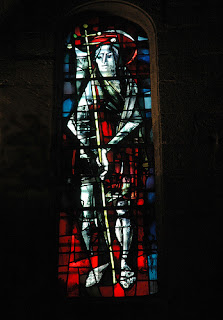The south of France has a number of “perched villages”—settlements on rocky hilltops—and they are extremely picturesque. After our trip to Arles, we headed over to the perched village of Les-Baux-de-Provence, which has had human settlements since at least Roman times. Like many such sites around this area, it was built on a hilltop for a reason: protection against attackers. And at the highest point of the village you can tour the ruins of a fortress.
The village of Les Baux—the “Baux” rhymes with “mow”—is in a region of small mountains called the Alpilles, pronounced al-PEEL. It’s a very scenic region; on the way to Les Baux our bus passed lots of olive groves and vineyards. Along the way we also learned that this region is where the mineral bauxite was first discovered. (“Baux” in French apparently means a prominent cliff, and the mineral was named after that.) And we learned that the town inspired writers ranging from Dante to the French poet and Nobel Prize winner Frederic Mistral. Mistral is a big deal around here; more on him another time.
On top of the hill in Les Baux, you can wander around the old village’s narrow cobblestone streets, which are lined with cafes, museums, and shops, or visit the small 12th-century church, the Eglise St-Vincent. The church is still in use, and in fact there’s quite a demand to get in to its Christmas services. Reservations are required. The old-town Les Baux also offers a lovely view of the fancy homes in the more modern village down below, which has a population of about 450. Quite a few of us in the Penn State group saw homes we would love to own.
After Les Baux, we headed off to the town of St-Rémy, perhaps most famous as the site of St-Paul-de-Mausole, a mental home where Vincent Van Gogh spent a year. Van Gogh lived in Provence for the last two years of his life, and as far as I can tell, he was hospitalized most of that time—first in Arles, as mentioned in a previous post, and then in St-Rémy. In the case of the St-Paul hospital near St-Rémy, he was committed there at his request from May 1889 to May 1890, and during that time he painted some very famous stuff, including Starry Night. Our guide said that many scholars believe that the town pictured in Starry Night is in fact St-Rémy. We toured the grounds of the St-Paul hospital, which dates to the 12th century and which is still in operation today. The area that tourists can visit includes a replica of Van Gogh’s room from when he was a patient there, as well as a gift shop with all kinds of Van Gogh-themed materials: books, posters, postcards, refrigerator magnets, and the like.
A short walk from the St-Paul clinic is a very small village called Glanum, where even more Roman ruins can be found. There’s a triumphal arch at Glanum, but right now it’s being repaired, so it’s totally blanketed in scaffolding—not much to look at. Apparently it was built around 10 B.C., during the reign of Augustus.
Our next day will take us to Orange, site of an incredibly large and well-preserved Roman theatre, as well as Chateauneuf-de-Pape, a wine-making region, and Pont du Gard, a huge ancient Roman aqueduct over the Gardon River. I’ll report on those sites next.
 With the French presidential election on Sunday, political signs for the two candidates could be found everywhere.
With the French presidential election on Sunday, political signs for the two candidates could be found everywhere.
 The gardens at Saint-Paul-de-Mausole, the mental hospital where Vincent Van Gogh spent a year (May 1889 to May 1890). Van Gogh painted a number of his most famous works—including “Starry Night”—while he was here. Saint-Paul-de-Mausole is near the town of Saint-Rémy-de-Provence.
The gardens at Saint-Paul-de-Mausole, the mental hospital where Vincent Van Gogh spent a year (May 1889 to May 1890). Van Gogh painted a number of his most famous works—including “Starry Night”—while he was here. Saint-Paul-de-Mausole is near the town of Saint-Rémy-de-Provence.
 The "perched village" of Les-Baux-de-Provence is a charming little village with cobblestone streets and shops.
The "perched village" of Les-Baux-de-Provence is a charming little village with cobblestone streets and shops.
 The church in the hilltop village of Les-Baux, the Igles St-Vincent, has modernistic stained-glass windows—a gift of the famous Grimaldi family of nearby Monaco.
The church in the hilltop village of Les-Baux, the Igles St-Vincent, has modernistic stained-glass windows—a gift of the famous Grimaldi family of nearby Monaco.
No comments:
Post a Comment